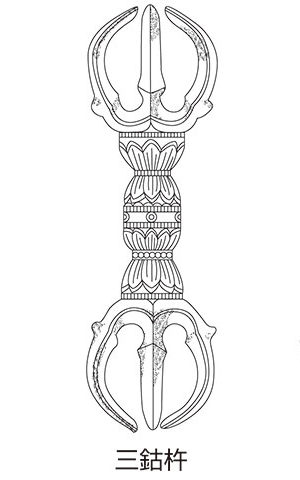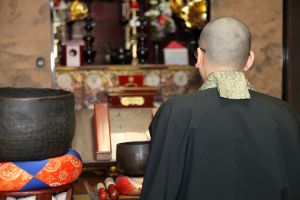密教法具の一種である金剛杵について

金剛杵(こんごうしょ)は、密教の儀式のときに使用する仏具であり、真言宗・天台宗・禅宗の日本仏教で修法のときに使用します。インドのヒンドゥ教の雷神インドラが持っていたといわれ、神話上の武器がモチーフにもなっています。その種類や効果についてご紹介します。
法具の意味

金剛杵は仏像や肖像画で弘法大師空海の右手に握られた仏具なので、見たことがあるという方も多いです。金剛は、ダイヤモンドのような非常に硬い物質(金剛石)を意味しており、人間の心の中の煩悩を打ち砕くと考えられています。
密教法具の金剛杵の使い方は、真言密教の秘儀とされているため仏門にはいり、阿闍利(あじゃり)から伝授されます。一般の方が使う場合は、精神統一をしながら、それを両手で包みこむように持ってください。自分の意識と肉体とが統一されることをイメージします。
もし、雑念が起きた場合は金剛杵で切る真似をすることで、雑念を切るができると考えられています。基本的な利用方法は誰でもすぐに行うことができます。精神統一をしたいときに、利用することで集中力を高めることもできます。
金剛杵は密教仏具の一種ですが、お守りや厄除けの効果があるため、アクセサリーで身に着けている方やインテリアの置物として自宅に飾っている方も多いです。「願いを実現する強力な力」があると考えられており、身近に置いておく方が多いです。
私たちが信じているお守りのように、願いをかなえてくれるアイテムですから私たちの身近で使用することができます。スピリチュアルなどを信じている方でしたら、パワーストーンのような感覚で使用することができます。
寺ガールといわれている趣味の人におすすめのアイテムですし、非常に力強く縁起も良い効果があるならお部屋のインテリアにも取り入れやすいです。種類も多いため、気になった金剛杵を身近に置いて願いをかなえてみましょう。
種
金剛杵は、「鈷」の本数によって呼称が変わるためデザインも異なります。刃が1本のものが独鈷杵(どっこしょ)と言い、念仏を唱えて祈りを捧げる人が仏様と一体になることを表現しています。刃の数は奇数のみになっています。
他に、刃が3本のものは三鈷杵(さんこしょ)で、祈る人の三業が、仏の三密にそのまま通ずることを表しているのが特徴です。刃が5本のものは五鈷杵(ごこしょ)と言い、五智が本来一体であることが、シンメトリーな形になっています。
片側だけ刃の代わりに鈴の形になっているものを金剛鈴と言い、修法の時に神仏と一体化になるために鳴らすものです。柄に鬼の顔の飾りがついた鬼面金剛杵があったり、金剛杵天珠など金剛杵の形によって危険や災厄を打ち払う魔除けといった意味を付加しています。
金剛杵(こんごうしょ、サンスクリット語: वज्र vajra ヴァジュラ、ヴァジラ[要出典]、チベット語:རྡོ་རྗེ; ワイリー方式:rdo rje ドルジェ)は、日本仏教の一部宗派(天台宗・真言宗・禅宗)[1]やチベット仏教の全宗派で用いられる法具。
仏の教えが煩悩を滅ぼして菩提心(悟りを求める心)を表す様を、インド神話上の武器に譬えて法具としたものである。
About Vajrayana, a type of esoteric Buddhist tool
Kongosho is a Buddhist tool used during esoteric Buddhist rituals, and is used during Buddhism in Shingon, Tendai, and Zen Buddhism. It is said to have been possessed by Indra, the Hindu thunder god of India, and has a mythical weapon as a motif. Introducing the types and effects.
Meaning of legal tools
Many people have seen the Vajra because it is a Buddhist tool held in the right hand of Kobo Daishi Kukai in Buddhist statues and portraits. Kongo means a very hard substance (golden stone) such as diamond, and is thought to crush the anxieties in the human mind.
Since the usage of the esoteric Buddhist esoteric Buddhist esoteric Buddhism is considered to be the mystery of Shingon esotericism, it is taught by Acharya when he enters the Buddhist gate. When used by the general public, hold it with both hands while unifying the spirit. Imagine that your consciousness and body are unified.
If you have any thoughts, it is thought that you can cut them by imitating cutting with a Vajra. Anyone can do the basic usage immediately. When you want to unify your mind, you can use it to improve your concentration.
Vajrayana is a type of esoteric Buddhist esoteric Buddhist esoteric Buddhist esoteric Buddhist esoteric Buddhist esoteric Buddhist esoteric Buddhist esoteric Buddhist esoteric Buddhist esoteric Buddhist esoteric Buddhist esoteric Buddhist esoteric Buddhist esoteric Buddhism. It is thought that there is “a powerful power to realize wishes”, and many people keep it close to them.
Like the amulet we believe in, it is an item that fulfills your wishes, so you can use it close to us. If you believe in spirituality, you can use it like a gemstone.
This item is recommended for people who have a hobby called a temple girl, and if it is very powerful and has a good auspicious effect, it is easy to incorporate it into the interior of the room. There are many types, so let’s put the Vajra that you are interested in close to you and make your wish come true.
seed
The design of the Vajra is different because the name changes depending on the number of “鈷”. The one with one blade is called Dokkosho, which expresses that the person who sings the Nembutsu and prays becomes one with the Buddha. The number of blades is only odd.
In addition, the one with three blades is Sankosho, which is characterized by the fact that the three works of the prayer can be directly connected to the Three Cs of the Buddha. The one with five blades is called Gokosho, and the fact that Gochi is originally one is a symmetric shape.
The one that has a bell shape instead of a blade on only one side is called a Kongo bell, and it rings to become one with the gods and Buddha during the training. There is a demon-faced Vajra with a demon’s face decoration on the handle, and the shape of the Vajra, such as the Vajra pearl, adds the meaning of a talisman to dispel danger and disaster.
Kongosho, Sanskrit: वज्र vajra Vajra, Vajra [Source], Tibetan: རྡོ་ རྗེ; Wiley method: rdo rje ] And the legal tools used in all denominations of Tibetan Buddhism.
The Buddhist teachings destroy the worldly desires and express the bodhicitta spirit (the spirit of seeking enlightenment), which is likened to a weapon in Indian mythology.
